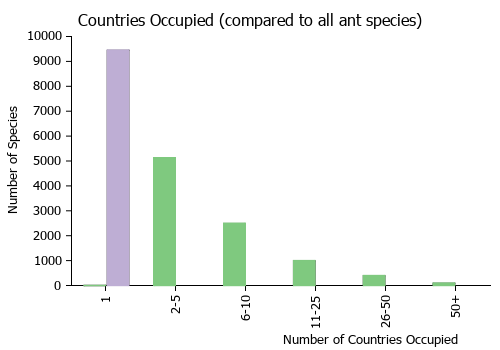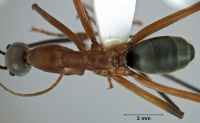Leptomyrmex tibialis
| Leptomyrmex tibialis | |
|---|---|

| |
| Leptomyrmex tibialis | |
| Scientific classification | |
| Kingdom: | Animalia |
| Phylum: | Arthropoda |
| Class: | Insecta |
| Order: | Hymenoptera |
| Family: | Formicidae |
| Subfamily: | Dolichoderinae |
| Tribe: | Leptomyrmecini |
| Genus: | Leptomyrmex |
| Species: | L. tibialis |
| Binomial name | |
| Leptomyrmex tibialis Emery, 1895 | |
| Synonyms | |
| |
L. tibialis has been recorded in rainforest, wet sclerophyll and dry sclerophyll. Nests occur in cavities in live or dead trees, and in soil at tree bases.
| At a Glance | • Replete Workers |
Identification
The largest of the Leptomyrmex species, L. tibialis can be identified by its large body size (HW 1.68–1.96; WL 4.51–5.13), broad head (CI 0.71–0.79), the 10+ standing hairs on the posterior face of the hind tibia, and its distinctive coloration. The majority of the body is rufotestaceous, with only the gaster, tibiae and distal portions of femora black. This species can be distinguished from its sister species by tibial coloration (pale in Leptomyrmex nigriventris; dark in L. tibialis) and by more pronounced tibial compression in L. tibialis (HTC 0.34–0.49 vs. HTC 0.52–0.66 in L. nigriventris). These two species co-occur in the region of Dorrigo, New South Wales. (Lucky and Ward 2010)
Identification Keys including this Taxon
Distribution
Latitudinal Distribution Pattern
Latitudinal Range: -22.865° to -28.80694°.
| North Temperate |
North Subtropical |
Tropical | South Subtropical |
South Temperate |
- Source: AntMaps
Distribution based on Regional Taxon Lists
Australasian Region: Australia (type locality).
Distribution based on AntMaps
Distribution based on AntWeb specimens
Check data from AntWeb
Countries Occupied
| Number of countries occupied by this species based on AntWiki Regional Taxon Lists. In general, fewer countries occupied indicates a narrower range, while more countries indicates a more widespread species. |

|
Estimated Abundance
| Relative abundance based on number of AntMaps records per species (this species within the purple bar). Fewer records (to the left) indicates a less abundant/encountered species while more records (to the right) indicates more abundant/encountered species. |

|
Biology
Castes
Phylogeny
| Leptomyrmex |
| ||||||||||||||||||||||||||||||||||||||||||||||||||||||||||||||||||||||||||||||||||||||||||||||||||||||||||||||||||||||||||||||||||||||||||
Based on Barden et al., 2017. Note only selected Leptomyrmex species are included.
Nomenclature
The following information is derived from Barry Bolton's Online Catalogue of the Ants of the World.
- tibialis. Leptomyrmex nigriventris var. tibialis Emery, 1895g: 351 (w.) AUSTRALIA. Wheeler, W.M. 1934c: 96 (ergatoid q., m.). Subspecies of nigriventris: Wheeler, W.M. 1934c: 96. Raised to species: Lucky & Ward, 2010: 55. Senior synonym of hackeri: Lucky & Ward, 2010: 55.
- hackeri. Leptomyrmex nigriventris subsp. hackeri Wheeler, W.M. 1934c: 99 (w.) AUSTRALIA. Junior synonym of tibialis: Lucky & Ward, 2010: 55.
Type Material
- Leptomyrmex nigriventris tibialis: Lectotype (designated by Lucky & Ward, 2010), worker, Laidley, Queensland, Australia, Museo Civico di Storia Naturale, Genoa.
- Leptomyrmex nigriventris hackeri: Syntype, 2 workers (1 missing gaster), Stradbroke Island, Queensland, Australia, Museum of Comparative Zoology.
- Leptomyrmex nigriventris hackeri: Syntype, workers, Stradbroke Island, Queensland, Australia, Museum Victoria, Melbourne.
Lucky and Ward (2010) - In the original description of L. tibialis Emery (1895) stated that it was “recolté dans le nord du Queensland par M. Podenzana” but this is an evident error since this species does not occur in north Queensland. Moreover, the apparent syntype series in MSNG is from Laidley, in southern Queensland. The series comprises two workers of what is here interpreted as L. tibialis (agreeing with the original description, particularly with regard to tibial compression) and three workers of L. cnemidatus. To fix the identity of this species we have designated one of the non-cnemidatus workers as the lectotype.
Unless otherwise noted the text for the remainder of this section is reported from the publication that includes the original description.
Description
Worker
Lucky and Ward (2010) - HL 2.31–2.63, HW 1.68–1.96, MFC 0.37–0.47, IOD 0.98–1.16, SL 3.77–4.30, EL 0.43–0.52, WL 4.51–5.13, PW 1.46–1.64, DPW 0.53–0.68, HTL 4.96–5.89, HTWmin 0.12–0.21, HTWmax 0.35–0.43, CI 0.71–0.79, SI 2.02–2.26, OI 0.09–0.11, HTC 0.34–0.49.
As in Leptomyrmex nigriventris, but generally larger (HW 1.68–1.96; WL 4.51–5.13 vs. L. nigriventris HW 1.49–1.76; WL 4.32–4.98), with head broader (CI 0.71–0.79 vs. CI 0.66–0.75). Tibiae are dark (vs. rufotestaceous) and more distinctly compressed (HTC 0.34–0.49 vs HTC 0.52–0.66).
Queen
Lucky and Ward (2010) - Head broader than in worker. Three ocelli deeply set into head in triangular formation, the anteriormost one largest, the posterior two smaller. Pronotum, mesonotum and propodeum voluminous, convex. The anterior portion of the mesonotum elevated, the posterior portion with a narrow impression before rising to the metanotal suture. Dorsal face of propodeum slightly concave. Petiole broader and higher than long, with a longitudinally grooved summit. Gaster nearly as high as long, somewhat laterally compressed, larger than in worker. Scapes, femora and tibiae broad, robust.
Surface of body subopaque, shagreened. Queen coloration similar to that of worker ; distal portions of femora deep black.
Male
Lucky and Ward (2010) - HL 1.77–1.98, HW 1.39–1.61, SL 0.72–0.78, EL 0.68–0.79, HTL 4.74–5.14, CI 0.74–0.82, SI 0.47–0.54, SI2 1.26–1.46.
Wheeler (1934) - Differing from the male of the typical Leptomyrmex nigriventris in having the head shorter, especially behind the eyes, in lacking the dark spots on the mesonotum, in having the tibiae and tips of the femora dark brown and the wings of a distinctly more yellow tinge. There is also a difference in the shape of the volsellae of the genitalia, which have the prongs of their pickaxe-shaped tips stouter and much more nearly of the same length.
References
- Lucky, A. 2011. Molecular phylogeny and biogeography of the spider ants, genus Leptomyrmex Mayr (Hymenoptera: Formicidae). Molecular Phylogenetics and Evolution 59: 281-292. doi:10.1016/j.ympev.2011.03.004
- Lucky, A. & Ward, P.S. 2010. Taxonomic revision of the ant genus Leptomyrmex Mayr. Zootaxa 2688: 1-67. PDF
- Wheeler, W. M. 1934c. A second revision of the ants of the genus Leptomyrmex Mayr. Bulletin of the Museum of Comparative Zoology 77: 69-118.
References based on Global Ant Biodiversity Informatics
- Lucky A., and P. S. Ward. 2010. Taxonomic revision of the ant genus Leptomyrmex Mayr (Hymenoptera: Formicidae). Zootaxa 2688: 1-67.
- Shattuck S. O. 1994. Taxonomic catalog of the ant subfamilies Aneuretinae and Dolichoderinae (Hymenoptera: Formicidae). University of California Publications in Entomology 112: i-xix, 1-241.
- Wheeler W. M. 1934. A second revision of the ants of the genus Leptomyrmex Mayr. Bulletin of the Museum of Comparative Zoology 77: 69-118.

